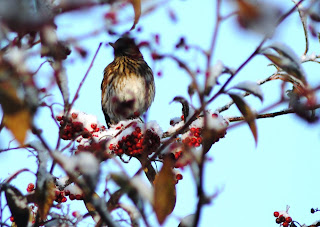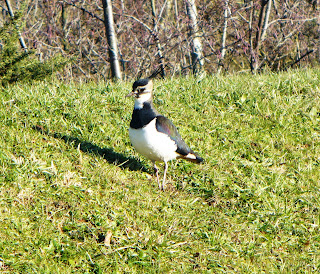This blog may help people explore some of the 'hidden' issues involved in certain media treatments of environmental and scientific issues. Using personal digital images, it's also intended to emphasise seasonal (and other) changes in natural history of the Swansea (South Wales) area. The material should help participants in field-based modules and people generally interested in the natural world. The views are wholly those of the author.
Wednesday, 29 December 2010
Wednesday, 22 December 2010
Tuesday, 21 December 2010
Winter Visitors
In Loughor, had a Red fox (Vulpes vulpes) roaming the garden at 2am. You can see the marks made by its brush along with its tracks in the snow. Also lots of evidence in the snow of bird visitors and a male Great spotted woodpecker (Dendrocopos major) frequented the feeder.
Monday, 20 December 2010
Birder's Bonus 87
Lots of activity in the Loughor berry trees with Redwing (Turdus iliacus) and Blackbird (Turdus merula) both scoffing.
Sunday, 19 December 2010
Seeing the Changes 337
In spite of the prevailing cold and snow the Grey squirrel (Sciurus carolinensis) were foraging. The Goat willow (Salix caprea) catkins in Loughor were even peeping through.
Saturday, 18 December 2010
Birder's Bonus 86
On the mudflats by the river Loughor, there were Redshank (Tringa totanus) and Dunlin (Calidris alpina). Lots of birds were feeding in the Loughor snow including Long-tailed tits (Aegithalos caudatus), Brambling (Fringilla montifringilla) and Redwing (Turdus iliacus).
Tuesday, 14 December 2010
Sunday, 12 December 2010
Saturday, 11 December 2010
Flutterby!
I very much like butterflies but I have to wonder whether the decline of some species in Europe (blamed on the effects of changing agricultural practices leading to fewer flower-filled meadows) needs to be reversed by going back to older production techniques (http://www.guardian.co.uk/environment/2010/dec/09/grassland-butterflies-decline-europe ). Presumably, the now threatened species were not so common before meadows were created and extended by human activities. It would seem better to uncouple the link between agriculture and the encouragement of these attractive species (very clearly a 'human' choice).
Friday, 10 December 2010
A Star Turn?
The story that materials extracted from the slime surrounding Scottish starfish may prove to be of medical importance seems just a bit premature (http://www.bbc.co.uk/news/science-environment-11931039). The starfish produce their 'goo' to prevent their surfaces being colonised by other species that surround them in their sea environment. In deed, the agents are described as being more effective than Teflon. The people involved in these studies suggest that these chemicals may give rise to drugs benefiting asthma, hay fever and arthritis patients. One could even suggest that drugs preventing materials sticking to the inside of blood vessels may result. What about chemicals preventing the build up of plaque on teeth? These materials are, however, a long way from generation (if they result at all). I seem to remember that claims about the plethora of potential agents to be extracted from marine organisms were made more than 30 years ago. There have been a few successes but these are very few and far between.
Wednesday, 8 December 2010
Birder's Bonus 82
A Lapwing (Vanellus vanellus) has taken to foraging amongst the molehills beside the Llanelli bypass.
Saturday, 4 December 2010
Birder's Bonus 81
The cold spell must be playing havoc with birds. On the estate in Loughor, saw a Grey heron (Ardea cinerea) perched on a garden fence!
Friday, 3 December 2010
Birder's Bonus 80
After feeling left out ot it, we finally got a sprinking of snow on the Gower-Carmarthenshire border. This seemed to stimulate many birds. At Loughor Bridge, a Buzzard (Buteo buteo) was being mobbed by 2 Carrion crows. There and all along the estuary, there was lots of Cormorant (Phalacrocorax carbo) activity. At Bynea, I noted the footmarks of a skating Moorhen (Gallinula chloropus). At Penclacwydd, Lapwing (Vanellus vanellus) fed in the fields and a Song thrush (Turdus philomelos) looked for snails to break on the cycle path.
Tuesday, 30 November 2010
Seeing the Changes 335
Very icy down by the river Loughor. Perhaps the cold drove a Red fox (Vulpes vulpes) out to forage in daylight around 14:00 hours at Bynea!
Tuesday, 23 November 2010
There Are Flies on Us
Interesting that an alien Latticed stinkhorn or Red Cage fungus (Clathrus ruber) has been recorded in Bishop's Wood Nature Reserve near Caswell on the Gower (http://www.bbc.co.uk/news/uk-wales-south-west-wales-11775363 ). The foul-smelling (like rotting meat) fungus attracts flies but has not previously been recorded in Wales.
Sunday, 21 November 2010
Seeing the Changes 334
Noted some Orange peel fungus (Aleuria aurantia) on dead Gorse at Penclacwydd. On the marsh there, horses were doing a sterling job mowing down the vegetation (important for some bird and insect species).
Losing Our Stripes?
There is recent sad news that the South China tiger (Panthera tigris amoyensis), a sub-species that is thought to be the ancestor of all tigers, is effectively extinct (http://www.worldwildlife.org/species/finder/southchinatiger/southchinatiger.html ). Not only has the beast not been seen in the wild for more than 25 years but it has recently been demonstrated, using molecular techniques, that the 'South China tigers' maintained by captive breeding in China are actually hybrids.
Wednesday, 17 November 2010
Around the Horn
News that the South African Government is to 'fight fire with fire' in an attempt to prevent the decimation of the country's rhinoceros is timely but disturbing (http://www.guardian.co.uk/environment/2010/nov/16/south-africa-war-on-poachers). Apparently, rhino horn is now worth more than gold in Chinese and Vietnamese markets as it has been claimed that a minister from the latter country was cured of cancer by taking the powdered material. This has led to the numbers of rhinoceros being killed by poachers in South Africa more than doubling this year (compared to 2009) to more than 260. Some farmers are said to be attacked on the suspicion that they might have rhino horn in the farm safe! It is all a little sad that conservation of these animals is imperilled in the search for something that has at best only a placebo action. They might just as well use powdered human hair.
Friday, 12 November 2010
Birder's Bonus 78
Strange goings on on the River Loughor near Bynea where a group of Black-headed gulls (Larus ridibundus) were going wild for something in the water. Sewage?
Monday, 8 November 2010
Autumn Mists at Golden Grove
Went for a nice walk at the Arboretum near Temple Bar Carmarthenshire. The light was striking as were the leaf colours en masse and individually. There were lots of toadstools (e.g. Mycena galericulata) and bracket fungi (e.g. Coriolus versicolor). In spite of the cold, Fresh flies (Sarcophaga carnaria) sunned themselves on tree trunks. There was also lots of feeding by antlered Fallow deer (Cervus dama) stags, especially enjoying chestnuts.
Saturday, 6 November 2010
Seeing the Changes 343
In Penclacwydd, the warmth and damp had brought out what was probably Dog lichen (Peltigera canina).
Monday, 1 November 2010
Birder's Bonus 77
Foraging in the dead thistles along the banks of the Loughor, at Bynea, were mixed flocks of Long-tailed tits (Aegithalos caudatus); Greenfinch (Carduelis chloris); Chaffinch (Fringilla coelebs) and Goldfinch (Carduelis carduelis).
Subscribe to:
Comments (Atom)
-
I n the UK and US, a pparently popular and successful vegan/vegetarian restaurants are reportedly closing or adding meat to their menus ( ...
-
Early ripening fruit may seem convenient but some folk think it confirms environmental stress. There's also a possibility th...














































+on+thistles+Penclacwydd.jpg)


+with+feather+Sandy+Water+Park.jpg)

%20mating%20NWCW.jpg)

